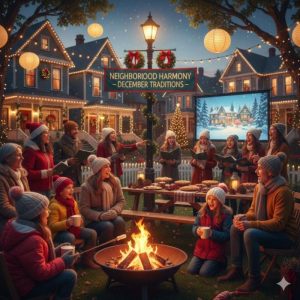December in U.S. neighborhoods is a month defined by warmth, belonging, and collective joy, even in the midst of cold weather. Community traditions—ranging from block parties to simple cocoa nights—transform familiar streets into lively hubs where families reconnect. Many communities even coordinate Christmas light installation together so the whole street lights up at once, reinforcing the sense of unity that defines the season. Some neighborhoods also hire full service Christmas light installation teams to help homeowners achieve a cohesive, professionally designed holiday look that elevates the entire street’s festive atmosphere. These gatherings create shared memories, nurture intergenerational ties, and strengthen social bonds, making December a uniquely cherished time for families across the country.
What Makes Neighborhood Block Parties an Important December Tradition?
Neighborhood block parties remain one of the strongest December traditions because they foster a festive environment where residents can gather, celebrate, and participate in communal joy. These block parties transform sidewalks and driveways into communal social spaces filled with lights, music, and shared laughter. For many families, this is one of the few times of the year when neighbors come together without the rush of daily life, making it a key driver of social cohesion during the holiday season.
Theme-Based Gatherings
Theme-based gatherings encourage creativity and participation, allowing residents to shape the party’s identity. Whether themed around “Winter Wonderland,” “Santa’s Workshop,” or “Vintage Christmas,” themes make planning easier and more fun. Families often dress according to the theme, decorate their homes accordingly, and even coordinate food and games that match the event concept. Themes create structure, giving neighbors a shared mission and enhancing the overall community spirit.
Shared Meal Tables
Shared meal tables offer families a practical way to connect while enjoying an assortment of foods. Long rows of tables decorated with holiday linens become communal dining areas filled with homemade dishes, warm conversations, and friendly laughter. This setting encourages neighbors to meet new people, share family recipes, and enjoy the sense of comfort that comes from eating together. The idea of sharing food continues to be one of the most effective ways to break social barriers.
Family-Friendly Games
Family-friendly games bring excitement to block parties and engage participants of all ages. Activities such as ornament races, snowball toss games, candy cane hunts, or holiday bingo help children feel involved while encouraging inter-family interactions. Adults also participate, turning the games into moments of friendly competition and collaboration. These shared playful moments help neighbors reconnect in ways that go beyond casual greetings.
Local Music and Performances
Local music and performances add a vibrant cultural layer to block parties, enriching the ambiance and bringing out local talent. Neighborhood kids might perform holiday songs, adults may bring instruments for live music, or local choirs might join to spread festive cheer. These performances create memorable experiences, transforming a simple gathering into a community celebration that resonates emotionally with families.
Table: Common Elements Found in December Block Parties
| Element | Contribution to Community |
|---|---|
| Themed decorations | Strengthens shared identity |
| Food stations | Encourages interaction |
| Music and performances | Enhances festive mood |
| Games and contests | Engages multiple age groups |
| Outdoor seating | Promotes long conversations |
How Do Neighborhood Potlucks Strengthen December Family Interactions?
Neighborhood potlucks strengthen December family interactions by promoting the spirit of sharing and togetherness. The collective preparation of food reinforces community bonds and gives residents the sense of belonging that many crave during the holiday season. Each family brings something meaningful to the table, ensuring a rich and diverse spread of dishes that reflect cultural heritage, family values, and personal recipes.
Recipe Exchanges
Recipe exchanges turn potlucks into educational, cultural, and culinary experiences. Neighbors often share handwritten recipe cards or digital versions of their favorite holiday dishes, showcasing traditions passed down through generations. This exchange encourages cultural appreciation, inspires creativity, and helps families expand their culinary skills while bonding over shared flavors.
Dietary-Inclusive Dishes
Dietary-inclusive dishes ensure that every member of the community feels valued and included, regardless of food preferences or restrictions. Options like gluten-free pies, vegan casseroles, and nut-free desserts make potlucks more inclusive. This attention to dietary diversity signals respect and care, reflecting the holiday spirit through thoughtful gestures.
Generational Cooking Traditions
Generational cooking traditions unfold beautifully in neighborhood potlucks. Families often prepare dishes that have been cherished for decades, passing down stories from older generations. Sharing these dishes with the community helps preserve cultural identity, strengthens intergenerational bonds, and encourages younger participants to appreciate family heritage.
Dessert-Focused Tables
Dessert-focused tables are often the highlight of neighborhood potlucks, offering a wide assortment of cookies, pies, cakes, and holiday treats. Children flock toward these tables, while adults enjoy tasting creations from neighbors. These dessert stations become social hubs, encouraging conversation and delight while showcasing community talent and creativity.
Why Are Outdoor Cocoa Nights a Popular December Tradition?
Outdoor cocoa nights are popular because they blend simplicity with warmth, comfort, and community connection. Families gather on lawns, driveways, or cul-de-sacs to sip warm cocoa under twinkling lights. These gatherings offer a low-pressure and family-friendly environment where neighbors can relax and unwind after busy holiday schedules. The combination of cold weather and warm drinks creates a cozy atmosphere perfect for conversation.
Hot Drink Stations
Hot drink stations often include cocoa varieties, flavored syrups, marshmallows, and whipped cream options. These stations allow children and adults to customize their drinks, making the experience interactive and enjoyable. The simple act of preparing cocoa together fosters bonding and brings families closer.
Winter Storytelling
Winter storytelling adds magic to outdoor cocoa nights. Parents, older neighbors, or community volunteers often read holiday stories or share local legends. These storytelling moments enrich children’s imaginations and create a nostalgic charm that resonates across generations.
Fire Pits & Heaters
Fire pits and patio heaters help keep the environment warm and comfortable. Families often gather in small clusters around these heat sources, turning the evening into a cozy retreat despite the chilly air. Fire pits also serve as visual focal points, enhancing the festive atmosphere.
S’mores Corners
S’mores corners add playful fun to outdoor cocoa nights. Families roast marshmallows, build s’mores, and share stories while enjoying the familiar flavors of this beloved treat. These corners become engaging spaces that encourage conversation and laughter.
How Does Community Caroling Bring Neighbors Closer Each December?
Community caroling strengthens neighborhood connections through music, shared participation, and collective joy. Groups of neighbors walk from house to house singing traditional holiday songs, spreading warmth and cheer. This tradition encourages active participation, strengthens local friendships, and creates lasting memories for families.
Street-by-Street Routes
Street-by-street routes ensure that all residents can participate or enjoy caroling. The planned routes help organize the event, allowing carolers to reach every home that wishes to hear or join. This structure fosters inclusiveness and consistency.
Harmonizing Groups
Harmonizing groups add musical richness and enhance the overall experience. Neighbors often form small groups based on vocal range, creating balanced harmonies that elevate the performance. This cooperation fosters teamwork and appreciation for one another’s talents.
Songbook Selections
Songbook selections help keep the tradition orderly and varied. Communities often use printed or digital songbooks that include a mix of popular carols, classical hymns, and contemporary holiday songs. These selections help everyone stay synchronized.
Children’s Participation
Children’s participation infuses caroling with energy and innocence. Young participants often lead favorite carols, add playful gestures, and brighten the experience. Their involvement encourages families to join and helps sustain the tradition for future generations.
Table: Key Benefits of Community Caroling
| Benefit | Impact |
|---|---|
| Encourages participation | Strengthens community ties |
| Spreads positivity | Boosts neighborhood morale |
| Multigenerational activity | Connects families of all ages |
| Promotes inclusiveness | Engages entire streets |
What Role Does Christmas Light Coordination Play in Neighborhood Unity?
Christmas light coordination plays a visually powerful role in neighborhood unity by synchronizing decorations across homes. When communities coordinate decoration weekends and themes, they create cohesive streetwide displays that attract admiration and create shared pride. Many neighborhoods coordinate Christmas light installation together so the whole street lights up at once, turning the act into a collaborative celebration.
Shared Installation Weekends
Shared installation weekends allow neighbors to help each other with ladders, tools, or ideas. This teamwork reduces individual effort and strengthens bonds through collaboration. Families often work side by side, exchanging stories and offering support.
Unified Design Themes
Unified design themes give neighborhoods a polished and coordinated look. Whether choosing warm white lights, multicolor strands, or specific design motifs, these themes create stunning curb appeal. The shared vision enhances the neighborhood’s festive spirit.
Home Façade Decorations
Home façade decorations add individuality while still adhering to the shared theme. Families may add wreaths, bows, garlands, or porch displays that complement the neighborhood’s overall look. These decorations allow residents to showcase creativity within the community framework.
Streetwide Lighting Ceremonies
Streetwide lighting ceremonies serve as the grand finale for coordinated lighting efforts. Families gather at an agreed-upon hour, count down together, and turn on their lights simultaneously. This powerful visual moment becomes a symbol of community unity and shared celebration.
How Do Small-Scale Local Markets Support Neighborhood Bonding?
Small-scale local markets support neighborhood bonding by creating spaces for commerce, creativity, and social interaction. These markets often appear in December as pop-up events featuring handmade crafts, baked goods, and seasonal decorations. Families visit booths, support local vendors, and enjoy the excitement of holiday shopping close to home.
Craft Booths
Craft booths showcase local talent and creativity, offering unique handmade items such as ornaments, wreaths, candles, or knitted goods. These booths foster appreciation for community craftsmanship.
Homemade Food Stalls
Homemade food stalls add delicious variety to the market experience. Neighbors prepare jams, cookies, breads, or savory snacks, allowing families to sample flavors from local kitchens.
Kid-Made Gifts
Kid-made gifts generate excitement and encouragement for young entrepreneurs. Children sell artwork, handmade jewelry, or holiday crafts, boosting their confidence and strengthening community support.
Neighborhood Vendor Tables
Neighborhood vendor tables allow local professionals to showcase their services and products. These interactions build trust and encourage families to support neighborhood businesses.
Conclusion
December neighborhood traditions play a profound role in strengthening family relationships and building community unity across the United States. From block parties and potlucks to coordinated Christmas lighting and local markets, these traditions bring warmth, connection, and shared joy to the holiday season. They help transform familiar neighborhoods into vibrant, supportive communities where families feel welcomed, valued, and connected.
FAQs
1. Why are December traditions important for neighborhoods?
December traditions foster connection, reduce social isolation, and create shared experiences that bring neighbors and families closer.
2. How do potlucks improve neighbor relationships?
Potlucks encourage sharing, cultural exchange, and meaningful interaction while celebrating diverse culinary traditions.
3. What makes outdoor cocoa nights appealing?
Their relaxed atmosphere, warm drinks, and cozy ambiance make them ideal for families seeking low-pressure community bonding.
4. Why do communities coordinate Christmas lighting together?
Coordinating Christmas lights creates visual unity, encourages teamwork, and allows the whole street to light up at once.
5. Are these traditions common across all U.S. neighborhoods?
Yes, while specifics vary, most U.S. neighborhoods embrace some form of seasonal gathering or shared holiday activity.






